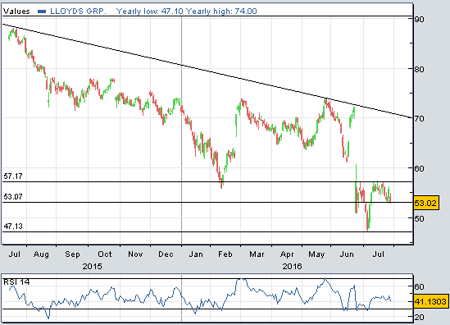Lloyds: when doubling profits isn't enough
28th July 2016 14:02
by Harriet Mann from interactive investor
Share on
Points mean prizes, but profits clearly don't. doubled earnings in the first half, but the high-street lender is slashing a further 3,000 jobs to save £1.4 billion amid warnings of a Brexit-inspired slowdown. With interest rates heading lower, nervous investors are selling.
Warning that Britain's exit from the EU could restrict capital generation, cost-cutting will shield Lloyds from what chief executive António Horta-Osório calls a likely "deceleration of growth".
Targeted savings are increased by £400 million, achieved in part by a fresh round of redundancies in addition to the 9,000 jobs and 200 branch closures previously announced in 2014.
Another 200 branches will shut by the end of 2017 and non-branch property will be cut by 30% in 2018. Savings initiatives are already making an impact, with operating costs down 3% to £4 billion in the first half. Lloyds has a market-leading cost:income ratio of 47.8%.
Pre-tax profit more-than doubled to £2.45 billion in the six months to 30 June, although last year's equivalent number was greatly affected by provisions and TSB costs.
Strip out one-offs and profit is down 5% to £4.2 billion when you include a £790 million loss on redemption of enhanced capital notes (ECNs). Total income slipped 1% to £8.9 billion, despite interest revenue inching 1% higher to £5.8 billion.

Generating the lion's share of banking turnover, Lloyds is going to find further rate cuts in the aftermath of Brexit hard to offset. Most economists expect this will happen next week.
Thankfully, there was no further provision for miss-selling payment protection insurance (PPI), although £16 billion has been paid in compensation since 2011. Impairment charges increased from £179 million to £245 million due to lower provision releases and write-backs from debt sales.
A return on required equity of 14% is down from 16.2% a year ago due to the banking tax surcharge, although it's still good enough to reflect a bank that's in good nick. However, one-off charges and second-quarter dividend accrual kept Lloyds' common equity tier 1 ratio (CET1) - a measure of financial strength - at 13%, 20 basis points below consensus.
The referendum means expected CET1 capital generation will be about 1.6% pre-dividend, 40 basis points less than expected, although UBS reckons this will still comfortably allow a 4p dividend. The group increased the interim dividend by 13% to 0.85p, although the market had wanted a whole penny.
With Lloyds guiding to full-year net interest margin steady at 2.7%, UBS expects full-year revenue of £17.3 billion and pre-tax profit of £5.6 billion - up from £1.6 billion in 2015 - giving diluted earnings per share of 6.8p.
"Some will see these results as numbers from a world we don't inhabit anymore. With rate cuts to come and the economy to slow, we think, we don't entirely disagree," says UBS analyst Jason Napier.
"But at 1.0x 2Q16 [tangible net asset value] with strong capital and a demonstrated ability to generate a 14% return in a tough market, we think the share is interesting for a longer-term investor."
He sticks with his 'buy' rating and 74p price target.
Lloyds shares slipped 5% Thursday to 53p and now trade 26% below pre-referendum levels. And, despite trading 13% above the three-year post-Brexit low, the shares are testing recently established support. If this level is broken, a trip back to 47p could be on the cards.
This article is for information and discussion purposes only and does not form a recommendation to invest or otherwise. The value of an investment may fall. The investments referred to in this article may not be suitable for all investors, and if in doubt, an investor should seek advice from a qualified investment adviser.